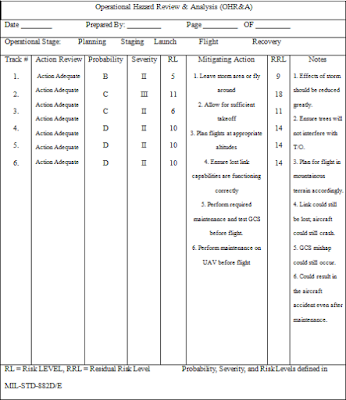9.7: Case Analysis Effectiveness
Joseph Younts
Embry Riddle Aeronautical University Worldwide
ASCI 638: Shawn Wynn
May 2017
Case Analysis Effectiveness
This is the second graduate course
that has required a case analysis to be developed on a specific research topic
of this author’s choosing. For the case analysis for ASCI 638: Human Factors in
Unmanned Aerial Systems, this author chose to write on the topic of fatigue
levels associated with UAS operators, particularly within the military due to
commercial UAV flights in the U.S. being limited in the amount of flight time
that can be achieved. The case analysis for this course allowed this author to
look at the issue of fatigue and UAV operators and determine what the issues
were, why the issues were significant, alternative actions that could be taken
to reduce fatigue levels, and a recommendation of my choosing to prevent
fatigue from leading to UAV accidents. This author found the case analysis to
be an effective tool when conducting research on the chosen topic. This author
also found this case analysis to be easier than the case analysis in ASCI 530
(this author wrote on detect, sense, and avoid technology) due to the relationship
between fatigue in manned aircraft pilots and UAV operators. Fatigue is an
issue that has been explored in great detail in manned aircraft operations, but
this author did spend some time searching for relevant information on the topic
of fatigue for UAS operators. Once relevant research was found, the alternative
actions and recommendations sections were much simpler to discuss due to the
fact that fatigue in unmanned and manned operations can be prevented in a
similar manner.
A
case analysis is an excellent tool for not only conducting research on a topic,
but also for understanding a decision making process. This author is currently
a full time college student working on his Bachelor's and Master's degrees, but
this author does see the potential for utility in what will hopefully be his
future line of work; a professional pilot. The case analysis tool allows a
student to move away from the standard format of a research paper and focus in
a relevant issues related to UAS operations. This author did find it hard to
write the recommendations section of the case analysis due to the simple fact
that the answer to the reduction of fatigue in UAS operators appears to be
centered around healthy eating habits, exercise, and proper sleep. These
methods can be directly applied to manned aircraft operations and have been for
years. This author was able to take some ideas from manned operations such as
bunk sleep, cockpit napping (or for UAS operations, ground control station
napping), short breaks, social interaction, and even development of new work
schedules.
A
case analysis allows a student to look at a problem from different
perspectives. There may be different methods to solve a problem, but the
student must choose two actions that are most likely to solve the issue in a
realistic manner. In the workplace, one worker will not have all the answers to
a problem. There will be times in which unique ideas will be the best way to
solve a problem. The case analysis tool used in this course allows a student to
look at the different perspectives surrounding an issue. As far as utility in
this author's future career, this tool will allow the author to logically
develop a mental model to solve problems on the ground and potentiality during
flight, but checklists that have been developed over time should have the
answers to most issues that occur in the cockpit.
The
layout of the case analysis is set in an orderly fashion that flows logically.
This author greatly appreciated the peer reviews that were conducted on the
abstract and the rough draft. Other students in the class had some interesting
ideas that helped this author complete the case analysis. As stated in this
authors' last review of the case analysis tool in ASCI 530, this author would recommend
a final peer review of the final draft of the case analysis. There does not
need to be a defense for this peer review, but having an extra set of graduate
school level eyes review the paper can be beneficial. This author also does not
feel that 20 pages is necessary for the case analysis, but reaching this page
length is dependent upon the chosen topic. As stated previously, this author
had trouble reaching the page limit for ASCI 530, but for this class, this
author was able to create a case analysis with 27 complete pages of information
due to the available information on manned aircraft fatigue and countermeasures
for preventing fatigue. For students choosing a topic for the case analysis, a
topic with plenty of information readily available should be chosen. This
should make the process of reaching the page limit easier.





